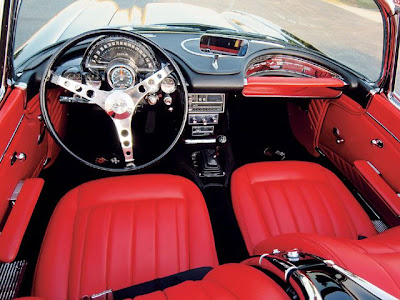Design
Although the style of a car can be as important to some as to how the car, the car manufacturers have started to pay attention to car designs until the 1920s. It was not until 1927, when General Motors hired designer Harley Earl, the car's style and design has become important for U.S. manufacturers. What Henry Ford did for automobile manufacturing principles, Harley Earl did for car design. GM's most extravagant "Dream Car" drawings of the 1950s are directly attributable to Earl, leading one journalist to comment that the designs were "the American psyche made visible." Harley Earl loved sports cars, and soldiers returning from overseas service in World War II brought home MGS, Jaguar, Alfa Romeo and others. Earl convinced GM that needs to build a sporty two-seater. The result was the 1953 Corvette, unveiled to the public at the Motorama car show this year.
The original Corvette emblem incorporated an American flag in its design, it was later abandoned when connecting the flag with a product that has been deprecated.
Taking its name from the corvette, a frigate combat small manageable (the credit for the nomination goes to Myron Scott), the first Corvettes were virtually hand-made in Flint, Michigan in Chevrolet Customer Delivery Center, now is a building University Kettering University. The outer body was made of a material called fiberglass revolutionary new compound, selected in part because of steel quotas left by the war. In this radical new body were standard Chevrolet components, including engine line "Blue Flame" six-cylinder truck, two-speed Powerglide automatic transmission, drum brakes and regular Chevrolet car line. Despite the engine's power is increased somewhat, thanks to a triple-carburetor intake exclusive to the Corvette, the car's performance was decidedly mediocre.
GM is seriously considering the project aside, leaving the Corvette to be little more than a footnote in automotive history, and would have done if there were two events. The first was the introduction in 1955 of Chevrolet V8 first motor (265 in � {4.3 L}) since 1919, and the second was the influence of a Soviet �migr� in GM's engineering department, Zora Arkus-Duntov. Arkus-Duntov simply took the new V8 and backed by a three-speed manual transmission. This modification, probably the largest in automotive history, helped turn the Corvette from a two-seat curiosity into a genuine artist. He also earned Arkus-Duntov the rather inaccurate nickname "Father of the Corvette."
The first generation is commonly called a solid axle, based on the fact that independent rear suspension (IRS) was not available before 1963.
The fuel injection
The first generation began in 1953 and completed in 1962, an addition worthy of note for the optional fuel injection in 1957. This is a new air intake system first saw regular use of gasoline engine two years prior to the Mercedes-Benz 300 SL Roadster "Gullwing". Although the Corvette GM-Rochester fuel system is used for continuous system fuel of style, unlike diesel nozzle style measurement system is the Mercedes' six cylinders, the system nevertheless produced about 290HP. The number was reduced to advertising for Chevrolet 283HP/283 in � (4.6 L) HP � a year with the slogan, and it is one of the first mass-produced engines in history to reach 1 hp / in �. In 1962, the GM Small-Block was extended to 327 in � (5.4 L) and produced a maximum of 360 hp (268 kW). Other options include power windows soon (1956), the hydraulically operated retractable roof (1956), four-speed manual (mid 1957), and heavy duty brakes and suspension options (1957).
Compared with British sports cars and Italian for the day was low-powered Corvette, required a great effort as well as open the door to get him to stop, and even missed a transmission "good" book. Until then, the Chevrolet division of GM entry-level brand, known for excellent cars, but no frills. Nowhere more evident than in the Corvette. A compressor Paxton became available in 1954 as a dealer-installed option, greatly improving the Corvette in a straight line performance, but sales continued to fall.







